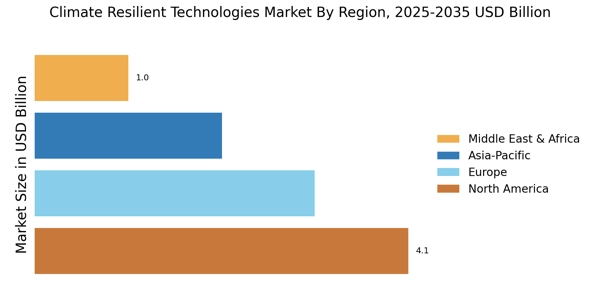Increasing Regulatory Support
The Climate Resilient Technologies Market is experiencing a surge in regulatory support from various governments. This support often manifests in the form of incentives, grants, and subsidies aimed at promoting the adoption of climate-resilient technologies. For instance, many countries have established frameworks that encourage investments in sustainable infrastructure and renewable energy projects. As a result, the market is projected to grow significantly, with estimates suggesting a compound annual growth rate of over 10% in the coming years. This regulatory environment not only fosters innovation but also enhances the competitiveness of climate-resilient technologies, making them more accessible to businesses and consumers alike.
Collaboration and Partnerships
Collaboration and partnerships among various stakeholders are emerging as a vital driver in the Climate Resilient Technologies Market. Public-private partnerships, along with collaborations between governments, NGOs, and the private sector, are fostering the development and deployment of innovative climate-resilient solutions. These partnerships often leverage shared resources and expertise, leading to more effective implementation of technologies. Market data indicates that collaborative projects have a higher success rate, with a 30% increase in project completion compared to isolated efforts. This trend highlights the importance of collective action in addressing climate challenges and advancing the market for resilient technologies.
Investment in Infrastructure Development
Investment in infrastructure development is a critical driver for the Climate Resilient Technologies Market. Governments and private entities are increasingly recognizing the need to build infrastructure that can withstand climate-related challenges. This includes investments in flood defenses, drought-resistant agricultural systems, and energy-efficient buildings. Recent reports suggest that infrastructure investments related to climate resilience could exceed $1 trillion over the next decade. Such investments not only create jobs but also stimulate economic growth while addressing the urgent need for climate adaptation. The focus on resilient infrastructure is likely to propel the market forward, creating opportunities for various stakeholders.
Rising Awareness of Climate Change Impacts
There is a growing awareness regarding the impacts of climate change, which is driving demand within the Climate Resilient Technologies Market. As communities and businesses recognize the potential risks associated with climate variability, there is an increasing push for solutions that can mitigate these effects. This heightened awareness is reflected in market data, indicating that investments in climate-resilient technologies have increased by approximately 15% over the past year. Stakeholders are now more inclined to adopt technologies that enhance resilience, thereby contributing to the overall growth of the market. This trend suggests a shift in priorities towards sustainability and long-term viability.
Technological Innovations and Advancements
Technological innovations play a pivotal role in shaping the Climate Resilient Technologies Market. Recent advancements in materials science, data analytics, and artificial intelligence are enabling the development of more effective and efficient climate-resilient solutions. For example, smart grid technologies and advanced weather forecasting systems are becoming increasingly prevalent, allowing for better resource management and disaster preparedness. Market analysis indicates that the integration of these technologies could lead to a reduction in operational costs by up to 20% for businesses adopting climate-resilient practices. This trend underscores the importance of continuous innovation in driving market growth and enhancing resilience.


















Leave a Comment